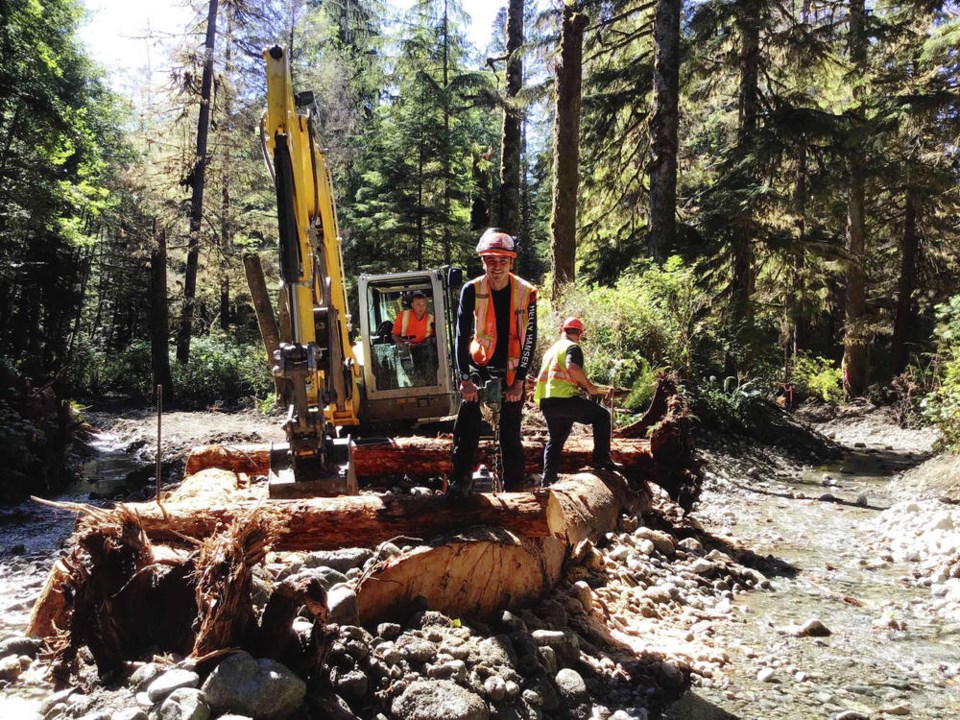A massive effort over the summer to remove silt, debris and log jams from salmon streams in the remote Cheewaht Lake watershed on western Vancouver Island is already showing signs of paying off.
The Ditidaht First Nation says it is encouraged by the discovery this fall of adult sockeye spawning in the three restored streams — it counted 3,400 fish and as many as 1,300 in a single day.
The Cheewaht Lake watershed in Pacific Rim National Park Reserve, near the mid-point of the West Coast Trail, had been clogged and washed out by past logging on the park’s borders, causing sockeye stocks that the Ditidaht people have relied upon for centuries for food to decline over the past three decades.
The $1.1-million project, funded through Parks Canada’s Conservation and Restoration program, saw more than 3,000 cubic metres of debris and sediment removed from just over a kilometre of the three streams. Banks were reinforced and logs strategically placed for enhanced spawning and rearing habitats.
It wasn’t an easy task.
Max Gerth of Port Alberni-based Roc-Star Enterprises, which was contracted for the restoration work, used small machinery to minimize impact on the surrounding old-growth forest, home to some of Canada’s oldest trees, including a 182-foot western red cedar known as the Cheewaht Giant, the largest of its kind in the world.
Gerth also modified a barge so it could be brought through the forest in two pieces and then assembled on the banks of Cheewaht Lake, where it was needed to transport crew and machinery to the remote streams. A “corduroy road” using logs was built to lessen the machinery’s footprints.
Prior to the work, fish in the restoration zones were released into Cheewaht Lake, and barrier nets were set up to stop them from migrating back.
Nanaimo biologist Mike Wright, who has worked with Ditidaht First Nation on the Cheewaht Lake watershed for 35 years, designed the restoration project, which involved returning the stream channels to historic routes, using natural materials at the site to stabilize the stream banks and lowering the stream-bed elevation to pre-logging levels.
Disturbed areas beyond the tops of the stream banks were restored with native plant species to stabilize the areas during storms.
The restoration project involved the Ditidaht First Nation, the Nuu-chah-nulth Tribal Council, federal and provincial governments, forest companies and private consultants and engineers.
Brian Tate, elected chief of the Ditidaht First Nation, said the restoration of the streams was of critical cultural importance for the nation.
“Logging practices very nearly wiped out the sockeye in the Cheewaht tributaries and river systems, with fewer and fewer spawning beds for sockeye to spawn in,” he said. “It’s a very important system to the Ditidaht people.”
Tate said Ditidaht families owned rights to certain spots on the Cheewaht River and built fish weirs to harvest sockeye. Young men would camp out on the Cheewaht River during the Sockeye run and harvest for families at Wyah, Clo-oose and Cheewaht villages.
“These salmon harvest practices built family bonding and unity through helping and sharing with each other,” he said.
The federal government added Cheewaht Lake and much of the Nitinaht Triangle to Pacific Rim National Park Reserve as part of the West Coast Trail Unit in 1973. However, between 1984 and 1992, parts of the northeast and east side of Cheewaht Lake were logged up to the boundary of the park. Runoff from those areas clogged streams and flooded others.
Fisheries began studying the Cheewaht watershed in 1985, tracking a steady decline in salmon runs and habitat, and the Ditidaht began to limit harvesting of Cheewaht salmon to protect the future of the runs.
Private, public and Indigenous groups came together to establish the Cheewaht Restoration Working Group in 2008 and — after a hiatus — again in 2017. The working group, which includes logging companies, B.C. Timer Sales, Teal Jones and Western Forest Products, continues to meet for detailed habitat mapping and spawning surveys, as well as geotechnical and hydrological assessments.



